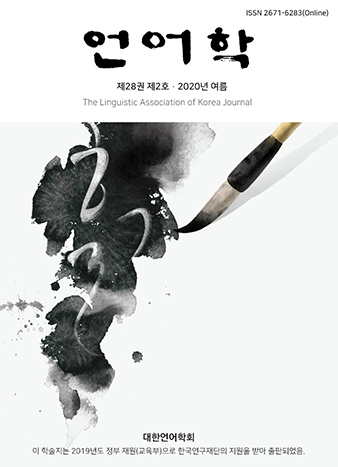대한언어학회 전자저널

28권 2호 (2020년 7월)
- A Questionnaire-based Survey on the Multilingual Use of College Students in Minority Areas
-
Yujie Shi
Pages :
Abstract
Shi, Yujie. (2020). A questionnaire-based survey on the multilingual use of college students in minority areas. The Linguistic Association of Korea Journal, 28(2), 57-68. Language is one of the essential means of communication that makes multilingualism has been closely related with sociolinguistics. The research of language use can provide information to teachers about learners needs and behaviors to the learning and teaching process and to give some support for the use of different languages. From the perspective of language life, this study investigates the multilingual use of 645 college students of foreign language college in Yanbian Korean Autonomous Prefecture through the method of literature review, questionnaire and statistical analysis to understand the linguistic situation and find out the reasons behind this situation. The study shows that students have the highest score on language use of Chinese language and language usage is affected by grade, major, ethnicity and educational background of parents. This study may contribute to enriching the relevant theories about multilingual use in minority areas abroad, providing practical experience for multilingual use in minority areas and the construction of multilingual, multicultural and harmonious language living environment.
Keywords
# multilingual use # college students # minority areas
References
- Cenoz, J. (2009) Towards multilingual education. United States: St Nicholas House.
- Chen, J. (2017). A survey of linguistic identity of minority in the Chinese border region with Vietnam. Journal of Yulin Normal University, 38(1), 95-98.
- Chen, L. (2018). Investigation and analysis of language identity of minority college students in Guangxi. Journal of Qinzhou University, 33(12), 81-89.
- Chen, M. (2015). A study on multilingual ability teaching focusing on foreign language learners. Studies on Language Literature, 12(6), 24-26.
- Chen, Y. L, & Lin, H. D. (2013). A comparative study of bilingualism between urban and rural students in Quanzhou area. Applied Linguistics, 22(1), 72-79.
- Davila, L. T. (2018). Multilingualism and identity: articulating ‘African-ness’ in an American high school. Race Ethnicity and Education, 5(11), 1-13.
- Duff, P. A. (2015). Transnationalism, multilingualism, and identity. Annual Review of Applied Linguistics, 36(35), 57–80.
- Fielding, R. (2015). Multilingualism in the Australian suburbs:A framework for exploring bilingual identity. Singapore: Springer.
- Fouser, R. J. (1997) Pragmatic transfer in advanced language learners: Some preliminary findings. Occasional Paper No. 50. Dublin: Centre for Language and Communication Studies, Trinity College, University of Dublin.
- Garcia, O., Lin, A., & May, S. (Eds.). (2017). Bilingual and multilingual education. Switzerland: Spring International Publishing.
- Hajek, J., & Goglia, F. (2019). The east Timorese in Australia: Multilingual repertoires, language attitudes, practices and identity in the diaspora. Journal of multilingual and multicultural development, 22(3), 1-18.
- Lado, R. (1957). Linguistics across cultures. AnnArbor: University of Michigan Press.
- Li, X. H. (2018). Language, culture and nationalities: Ethnic language identity and the construction of national common community. Journal of Northwest Minzu University (Philosophy and Social Science), 15(2), 7-12.
- Liu, C. C. (2011). A relevance study on Chinese language attitudes and Chinese language proficiency of Thai students. Unpublished master’s thesis, Jinan University, Guangzhou City, Guangzhou, China.
- Martinez, R. A, Durán, L., & Hikida, M. (2017). Becoming “Spanish learners”: Identity and interaction among multilingual children in a Spanish-English dual language classroom. International Multilingual Research Journal, 11(3), 167-183.
- Nguyen, T. T, T., & Nguyen, H. T. M. (2017). Thinking globally or “glocally”? Bilingual identity of Vietnamese international school students. International Journal of Educational Research, 34(85), 24-32.
- Savilova, S. L., Shchitova, O. G., Shchitova, D. A., & Malgozhata, L. (2015). The Verbal-semantic level of the foreign student language identity (Based on Internet discourse). Procedia - Social and Behavioral Sciences, 38(215), 312–315.
- Spolsky, B. (2004). Language policy. Cambridge: Cambridge University Press.
- Sun, D. P. (2011). Language identity and language change: A survey of language use in the Jianghan Oilfield. Applied Linguistics, 20(1), 27-37.
- Sun, Y. (2018a). Study on the language identity of border Korean nationality under bilingual background. Research on Higher Education of nationalities, 6(1), 54-57.